Was elemental cobalt used to the underglaze?
The cobalt would have been mined out of the earth, in the form of Cobalt oxide. Even ceramicists today use cobalt oxide, which creates deep blue hues.
I read that the rise of blue and white ceramics became popular in the Yuan dynasty -- what sparked this change in tastes and why did it persist this long?
While blue-and-white ceramics were created as early as the ninth century, the blue-and-white industry expanded greatly in the Yuan. Imperial support was given to the kiln city of Jingdezhen, which was a major producer of blue-and-white porcelain. Tastes for blue-and-white in the Middle East can be traced back to those earlier wares and, in the Yuan period, trade became much easier as Mongols ruled from China to Iran. As for its the style's staying power, I think there's just something very visually attractive to the combination of blue and white that crosses cultures and time periods.
What's the difference between porcelain and stoneware?
Porcelain is generally made with kaolin, white china clay, and petuntse, and retains its color when it is fired.
Porcelain becomes vitrified during the second firing in a two fire process whereas stoneware becomes vitrified during a single firing. Porcelain is also fired at temperatures in excess of 1300 degrees Celsius, which makes it more fully vitrified than stoneware. The slightly cooler firing temperature of stoneware gives it a warmer color than porcelain.
Thank you! So what would "porcelaneous stoneware" be?
Porcelaneous stoneware contains a mixture of the clays that go into true porcelain and stoneware. The result is a porcelain-like stoneware.
Why only blue in the Infinite Blue exhibition? What is the significance? Were other colors not available for porcelain, for instance?
Blue was traditionally a rare pigment and hard to find. Also, it's not as easy to work with as other pigments which allowed us to string a connective thread through our own collection. Narrowing the focus but still providing a diversity of objects through time and space allowed us to compare, contrast, and connect in new and interesting ways that would be difficult in a more traditional exhibition context. As for porcelain, there were other color choices available, but blue was the preference. At the time our Wine Jar with Fish and Aquatic Plants was made, the blue color came from cobalt which was imported across the Silk Roads from the Middle east. Cobalt was a luxury good and its use was a sign of wealth and power for the person who commissioned the Wine Jar.
A lot of these pieces are listed as "porcelain with cobalt underglaze." I thought that the silica content in porcelain was so high that it didn't need glazes to become glassy. So are these pieces glazed or unglazed? What makes a decoration underglaze? Is it just a general term for slip with pigment or something more?

You are correct that porcelain does not require a glaze but often received one for decorative purposes and for protection of the design.
The cobalt decoration can be applied under the glaze or on top, like a raised enamel. When you see "cobalt underglaze," it indicates the the cobalt was applied first. Cobalt at this time was imported from the Middle East into China, and was very expensive to produce. This is a luxury good made for high level officials and Confucian scholars at the court.
Ah I see. Thanks!
Tell me more.

Blue and white porcelain is among the most recognizable and globally popular forms of Chinese ceramics.
This wine jar was created toward the beginning of Chinese artisans' mastery of cobalt underglaze decoration and is an exceptional example of blue-and-white decoration.
The various fish motifs have auspicious connotations, one being that the names of the fish combined form a phrase that means “honest and incorruptible.” This is especially interesting as this is a wine jar used by high level court officials, and is a luxury good.
What is this about?
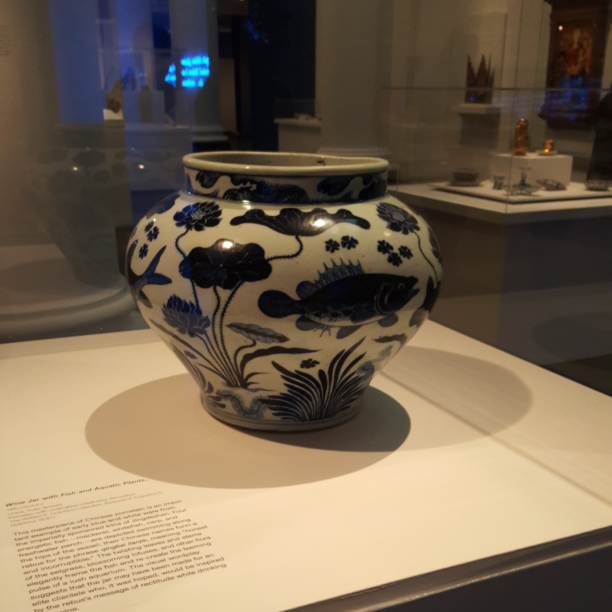
There is a lot of visual imagery with specific significance on this jar. There are four fish swimming among the aquatic plants around the jar and each one is a different species.
There is a Chinese perch, a common carp, a black carp, and a silver carp. Although fish had been a common motif in Chinese ceramics for thousands of years, this is a rare example where the fish have been executed with such realism and are so lively.
Cool!
The whole jar reads as a rebus. The 4 fish's names together form the Chinese phrase "honest and incorruptible." Even further, the Chinese word for carp is similar to words for profit, official, and Confucian morals. So all this imagery and its varied meanings would have made the jar a prestige object and a sign of scholarly knowledge for the owner, a Confucian scholar-bureaucrat with a high rank at court.
Thanks!
What did they use in the porcelain to get such deep blue?
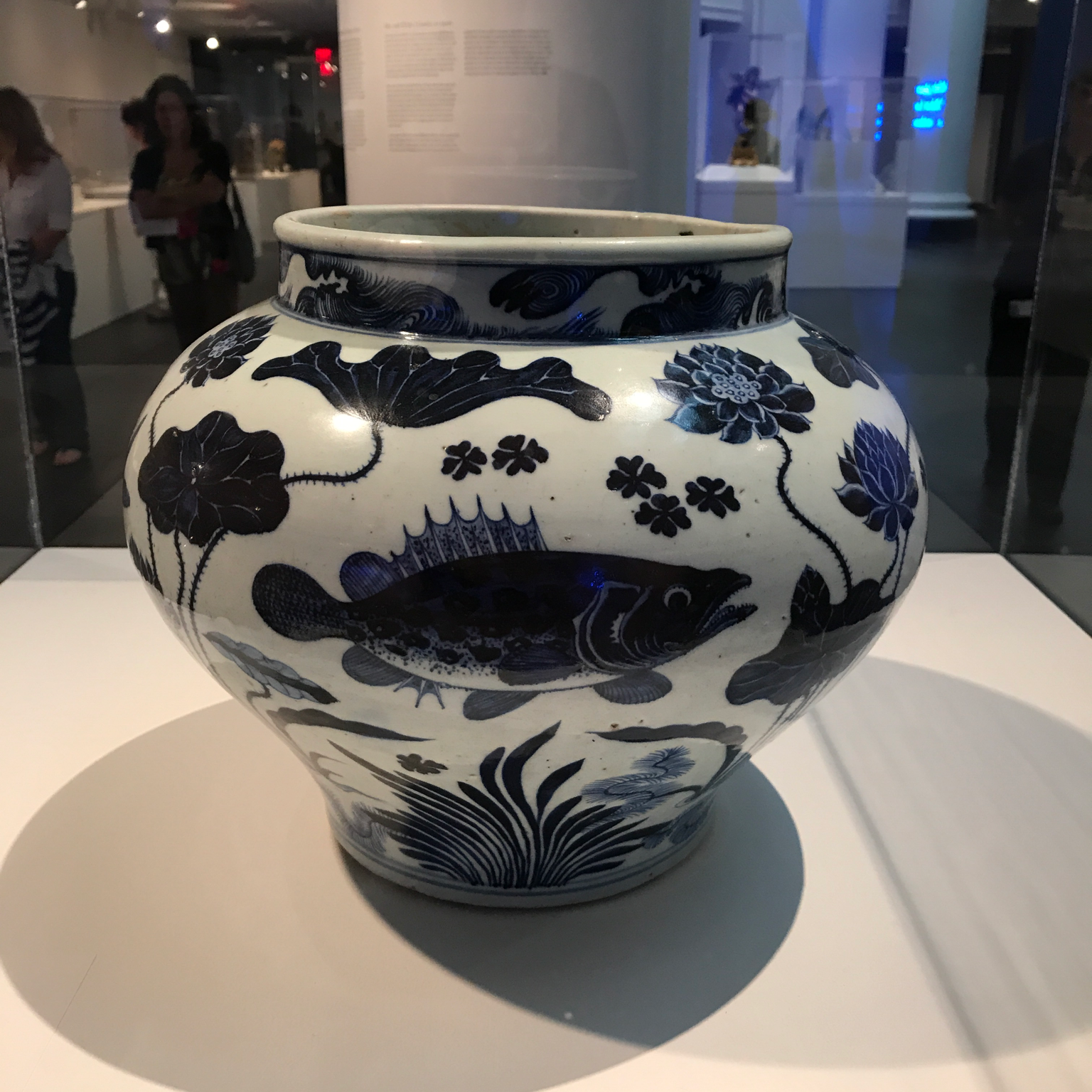
The color was produced with cobalt underglaze painting!
The mineral pigment is painted directly on the ceramic which is then glazed and fired. Cobalt was used because of its ability to withstand the high firing temperatures needed to create porcelain. Cobalt also produced the deep rich blue color with flecks of black in it.
Thank you!
What was the purpose of the Chinese ceramic vases: where they used for everyday life in the palace or were they purely decorative? Thank you!
A little bit of everything actually. Some, like the cloisonné "Tripod Censer" and the Yuan "Wine Jar With Fish and Aquatic Plants" were functional. The wine jar was likely owned by an elite official.
In most cases, the decoration played a large part in the use and presentation of the object. In the case of the wine jar for example, while it was used, all of the imagery and the knowledge needed to recognize it would have made it a prestige object for the owner, demonstrating his scholarly knowledge and wealth.
Got it. Thank you very much!
Tell me more.
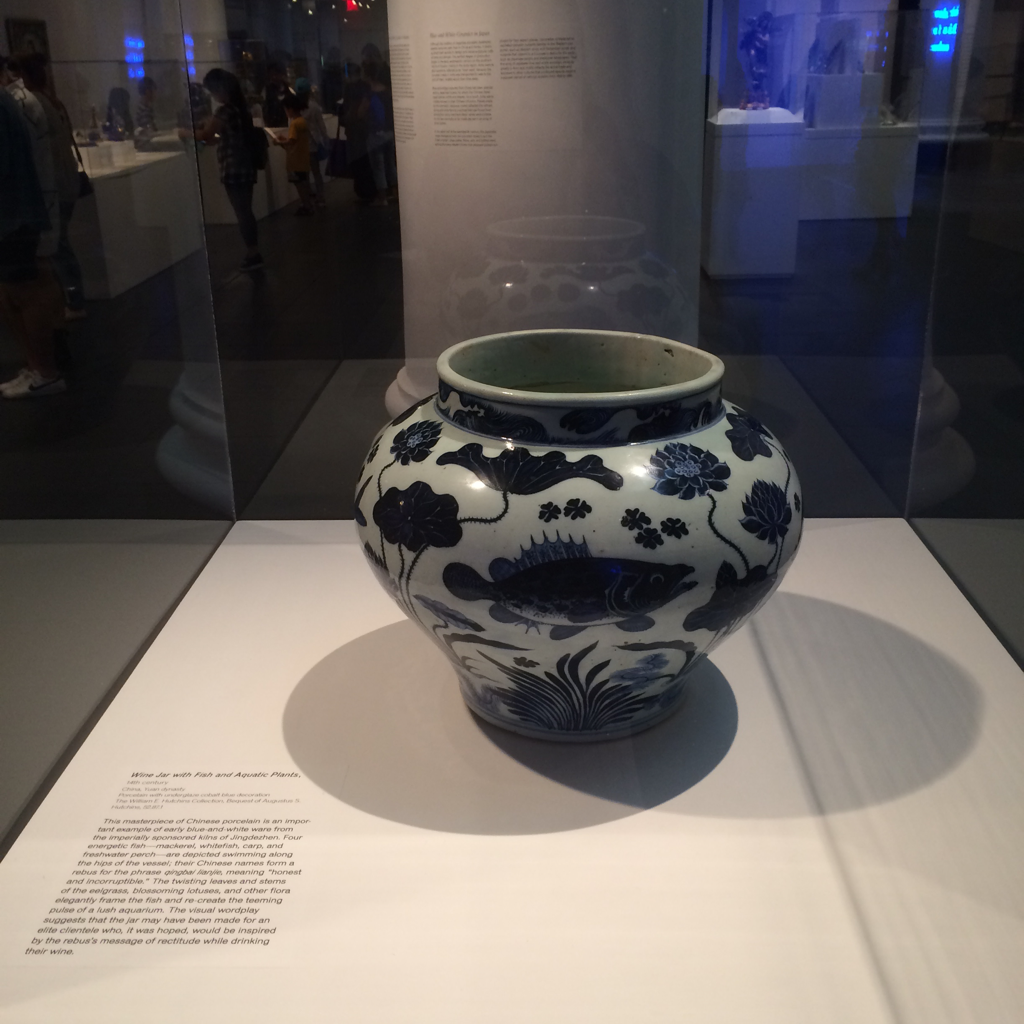
The perfect way in which the fish and plants are placed to fit the curvature of the jar shows the mastery of Chinese artisans in using cobalt to paint the design. In addition, the deep blue color highlights the design. The imagery on the jar has multiple levels of meaning.
The whole jar reads as a rebus. The four fish names together can be read as “qing bai lianjie” which translates to “honest and incorruptible.”
What is the significance of the number and type of the four fish depicted? Who used this, and what was their status?
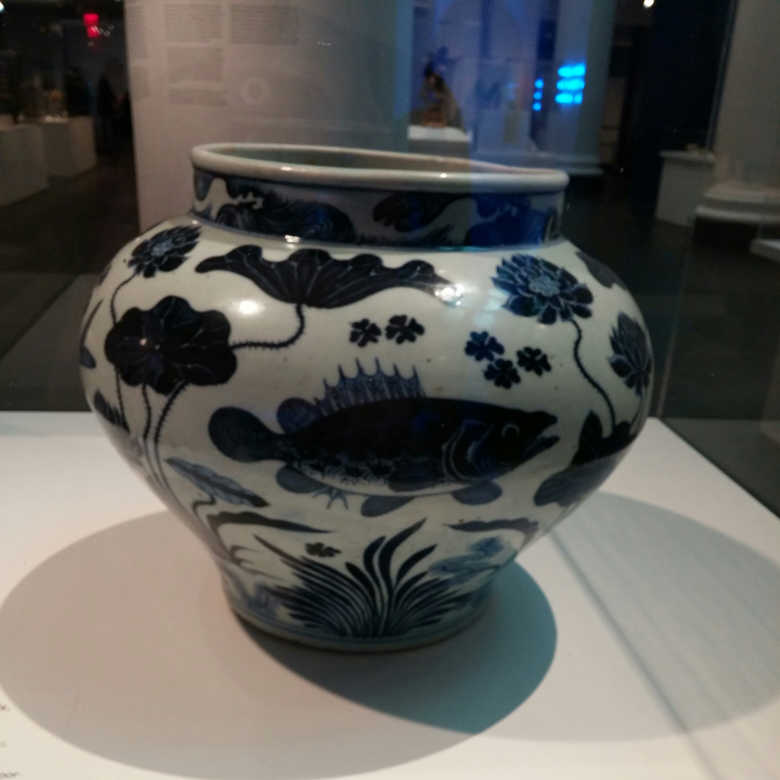
Well, the four fish taken together from what's called a rebus, a type of wordplay. The names of the four fish (mackerel, whitefish, carp, and freshwater perch) together read, in Chinese, as “qing bai lianjie” which translates to “honest and incorruptible.”
The Chinese word for fish is also similar to the word for abundance and the word for carp is similar to the words for profit, official, and Confucian morals. The image of a carp had thus become a metaphor for success.
With all of the meaning, this jar would have served as a prestige object and a sign of the scholarly knowledge of an elite member of society. It was designed to hold wine, likely at a scholarly gathering.
Thanks.
Was there a top for this?
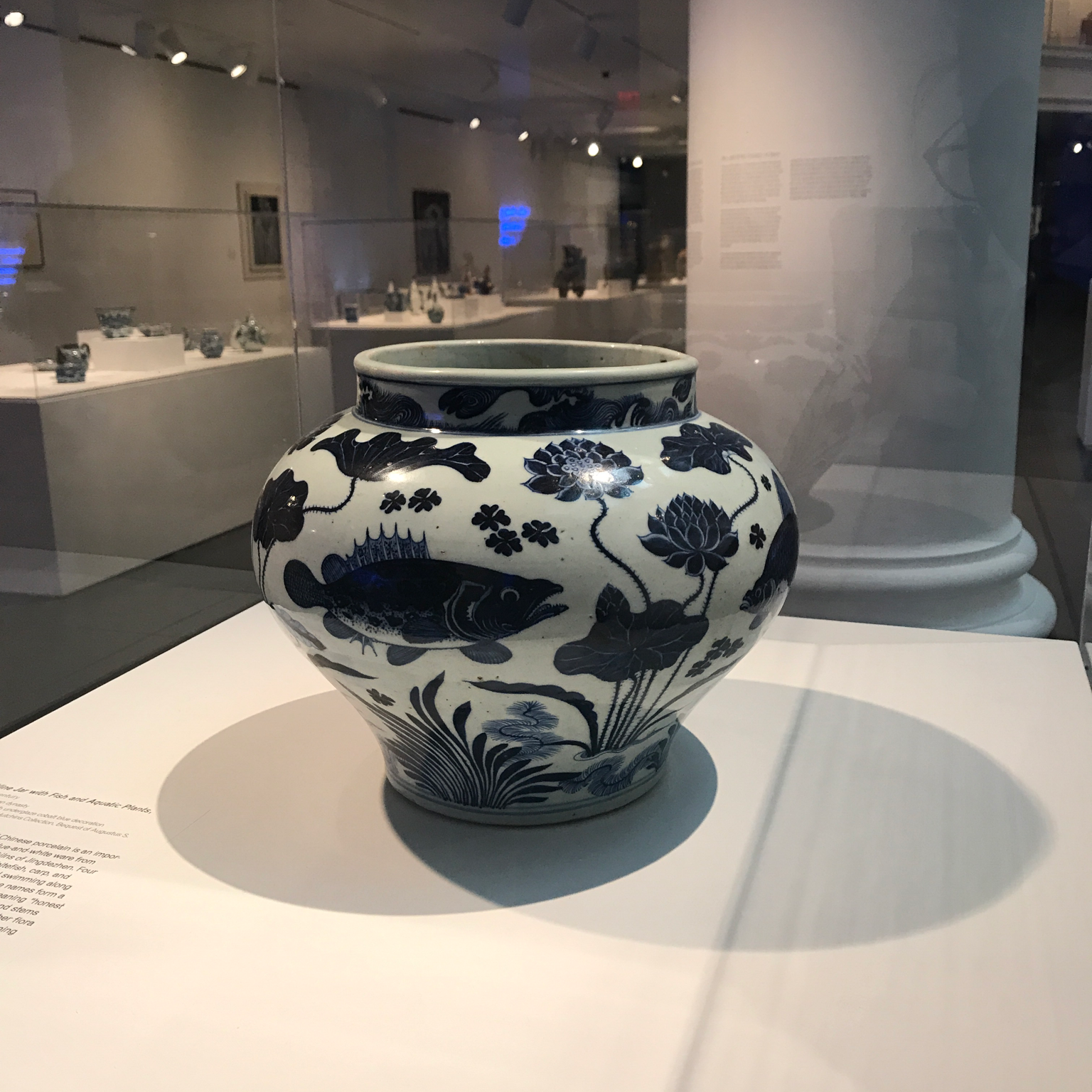
Yes, there would have been a lid or top for this. However, it was used for serving wine, rather than for storage.
What is this?
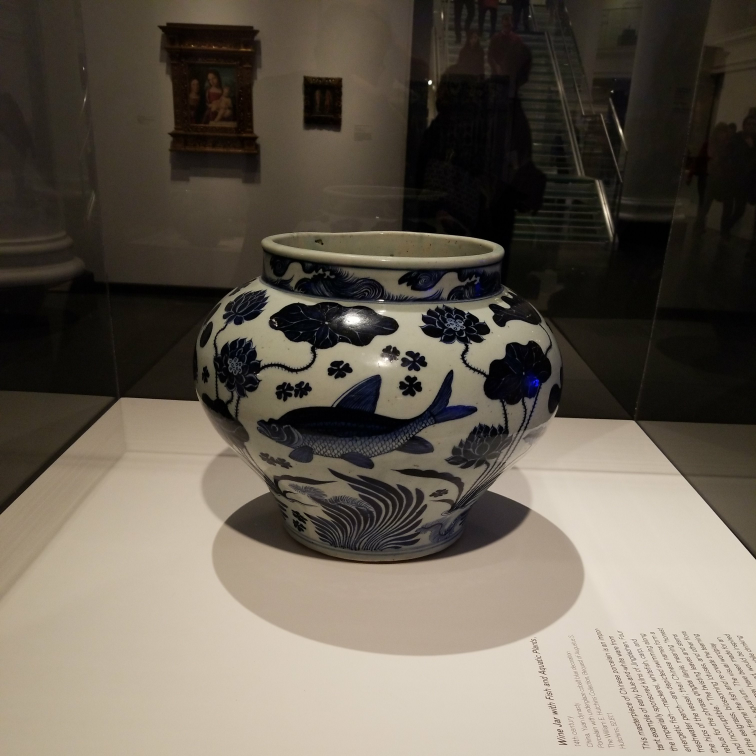
This is a wine jar! It is from Yuan Dynasty China, and was likely owned by an elite official.
The decoration shows a Chinese perch, a common carp, a black carp, and a silver carp in an impressive degree of realism. The jar was decorated using cobalt underglaze painting.
This piece seems extra riveting to me. The colors are rich, but the picture is almost simple. What makes it such a strong piece?

I would say that the visual qualities of the composition itself, the masterfully controlled glaze, and the meaning of the piece are all important factors!
You may have noticed, if you have had a chance to look at some of the other blue-and-white porcelain from China, that this composition is a bit different. It's more exact and incorporates more negative space thus making the figures themselves stand out.
The technical execution of this vessel and it's decoration are, of course, excellent.
And, if you've read the label you already know this, the names of the four species of fish can be read as a rebus puzzle. Qingbai lianjie also means "honest and incorruptible." This speaks to who would have owned such a vessel, an elite scholar looking to demonstrate his knowledge to his peers.
Agreed, maybe it's the execution.
Certainly the level of contrast both in the colors and in the composition make this particular vessel very visually commanding.
I read in the Infinite Blue exhibit, that Chinese ceramics were a marvel because elsewhere earthen pottery was the norm. What is ceramic made from?
Ceramics are made from many different types of clay. Earthenware is made by almost every culture in the world. It is made from common clay collected in low-lying regions like riverbeds.
Porcelain, which is what the marvelous Chinese ceramics are, is made from a pure white clay called kaolin. It is only found at higher elevations, further upstream, where it does not collect impurities like iron (which can be found in earthenware).
Another difference is the firing temperature. To create earthenware, the fire does not need to be especially hot. This was the first type of ceramic ever created in ancient times and can even be fired in pits!
Porcelain must be fired at a very high temperature that required a sophisticated kiln.
That is wonderful explanation! Thanks!
Some of the flora looks like land flora like chrysanthemums. Is there a meaning to this mixture?
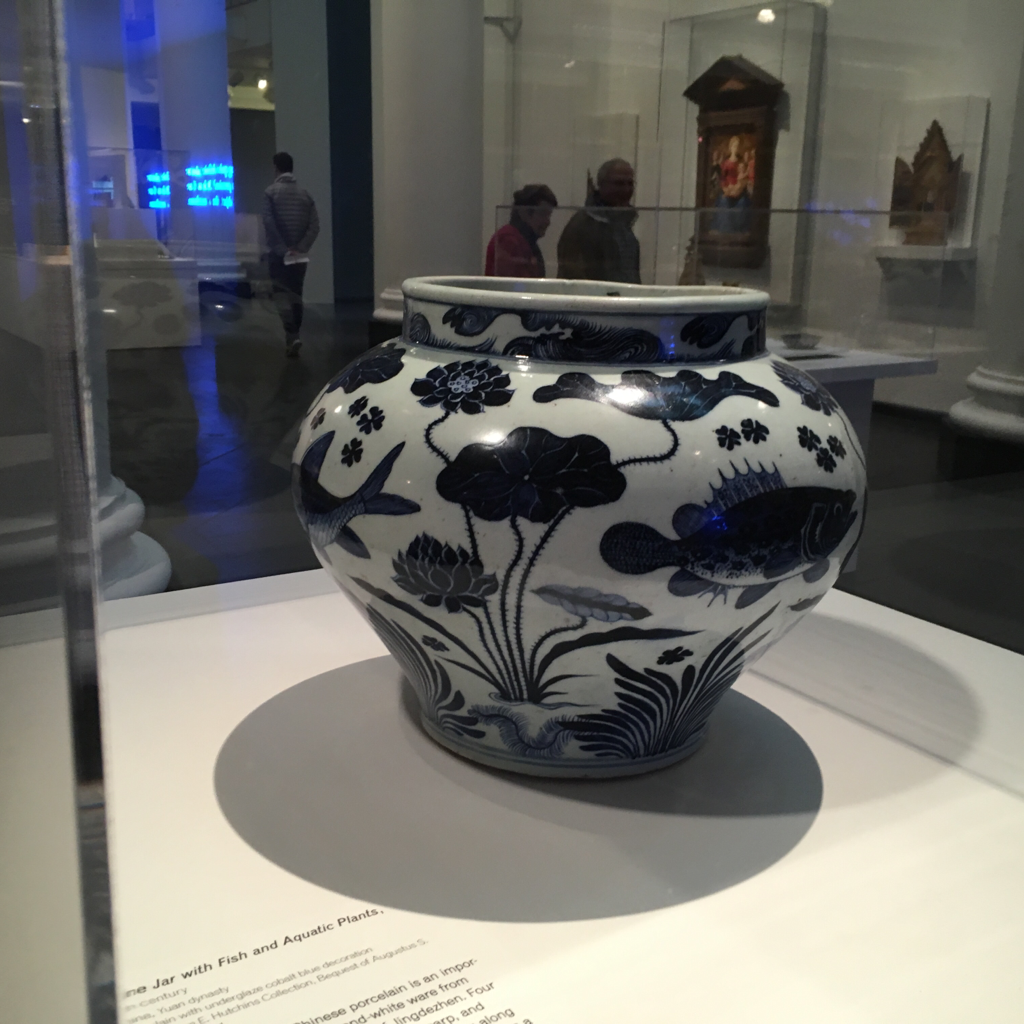
I believe most of the flora are aquatic, such as the eel grass and the blossoming lotuses. I can see how the blossoming lotuses could look like chrysanthemums.
Lotus flowers represent purity and were a common buddhist symbol! Chrysanthemums are also an auspicious symbol.
What was the significance of blue in Chinese culture throughout history?
In Chinese ceramics, the blue and white vessels often use cobalt, which was favored because it was one of the few pigments that held up to high temperatures when fired in a kiln...
As for the cloisonné works, the ones with the bright turquoise enamel on them, this use of blue had aesthetic as well as technological motives like cobalt in blue and white porcelain did, but it also had religious motives, referencing watery and heavenly settings.
Chinese celadons, meanwhile, are a much lighter, greener blue, and would have been glazed to appear like jade. This jade like surface was related to Confucian ideals, mirrored in jade as a material, which signified restraint, moral rectitude, and balance.
Thank you. So interesting. I always think of China and blue but I had no idea why except maybe blue pigments were available.
Part of the reason why you might associate China with blue is because blue and white porcelain in particular became a worldwide Chinese export in the 16th and 17th centuries. You can see examples of this in Infinite Blue as well, including American and European versions of Chinese blue and whites, made when the style was in high demand. And this type of ceramic is still widely available!
Yes, just read the plaque on that, plus the fact cobalt was not from China but the Middle East.
Wonderful service with the interaction.
We're glad you think so! And yes! Other blue materials like lapis lazuli were also imported to China, and highly prized!
Would this be a functional piece or decorative?
It's both. It would have actually held wine but the decoration was just as important.
The high quality blue and white porcelain, as well as the intricate design, heavy with symbolic significance, would have been a sign of prestige and scholarly knowledge.
Is there a significance to the type of fish and flowers on the jar?
There certainly is! The names of the fish, in Chinese, in order, are: qing bai lian jie. When read altogether, the phrase also means honest and incorruptible.
The four species are, in English: Chinese perch, common carp, black carp (mackerel), silver carp (whitefish). They are all native to China, as are the identifiable species of plants depicted on the jar.
How did they actually store wine in this jar?
It was definitely used for wine, however, probably for serving wine to important guests, rather than storing it away.
A special object like this would be something to show off to visitors! They could study the designs of fish and flowers while they drank and discussed their meanings.
The combination of the different fishes' names reads as a rebus. Put together, they form the Chinese phrase "honest and incorruptible." It's a very educated puzzle...




























































